Finance Case Studies: Ethical Dilemmas and Solutions
VerifiedAdded on 2020/04/29
|11
|2063
|172
Case Study
AI Summary
This document presents three case studies focusing on ethical issues within the finance industry. The first case examines a manufacturing firm's asset valuation and financial misrepresentation concerns, including the misuse of goodwill and the ethical dilemmas faced by auditors. The second case delves into whistleblowing, exploring the importance of whistleblower protection and the legal safeguards provided under Australian law. The final case analyzes Sleepy Time Ltd, an herbal remedy company, and identifies potential violations of the OECD principles of corporate governance, particularly concerning conflicts of interest within the board of directors and issues related to shareholder decisions. The analysis includes discussions on ethical decision-making models, potential solutions, and the importance of upholding ethical standards in financial practices.
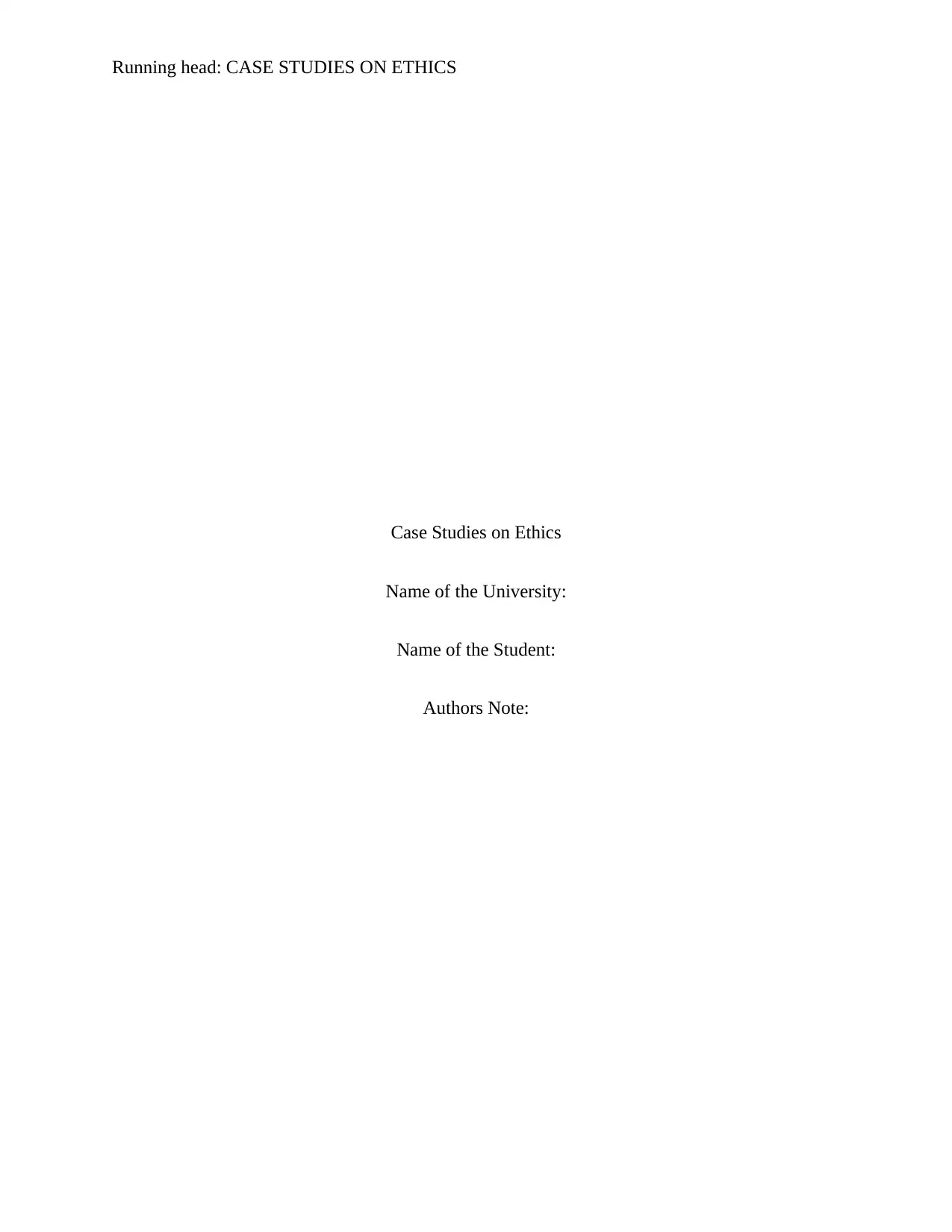
Running head: CASE STUDIES ON ETHICS
Case Studies on Ethics
Name of the University:
Name of the Student:
Authors Note:
Case Studies on Ethics
Name of the University:
Name of the Student:
Authors Note:
Paraphrase This Document
Need a fresh take? Get an instant paraphrase of this document with our AI Paraphraser
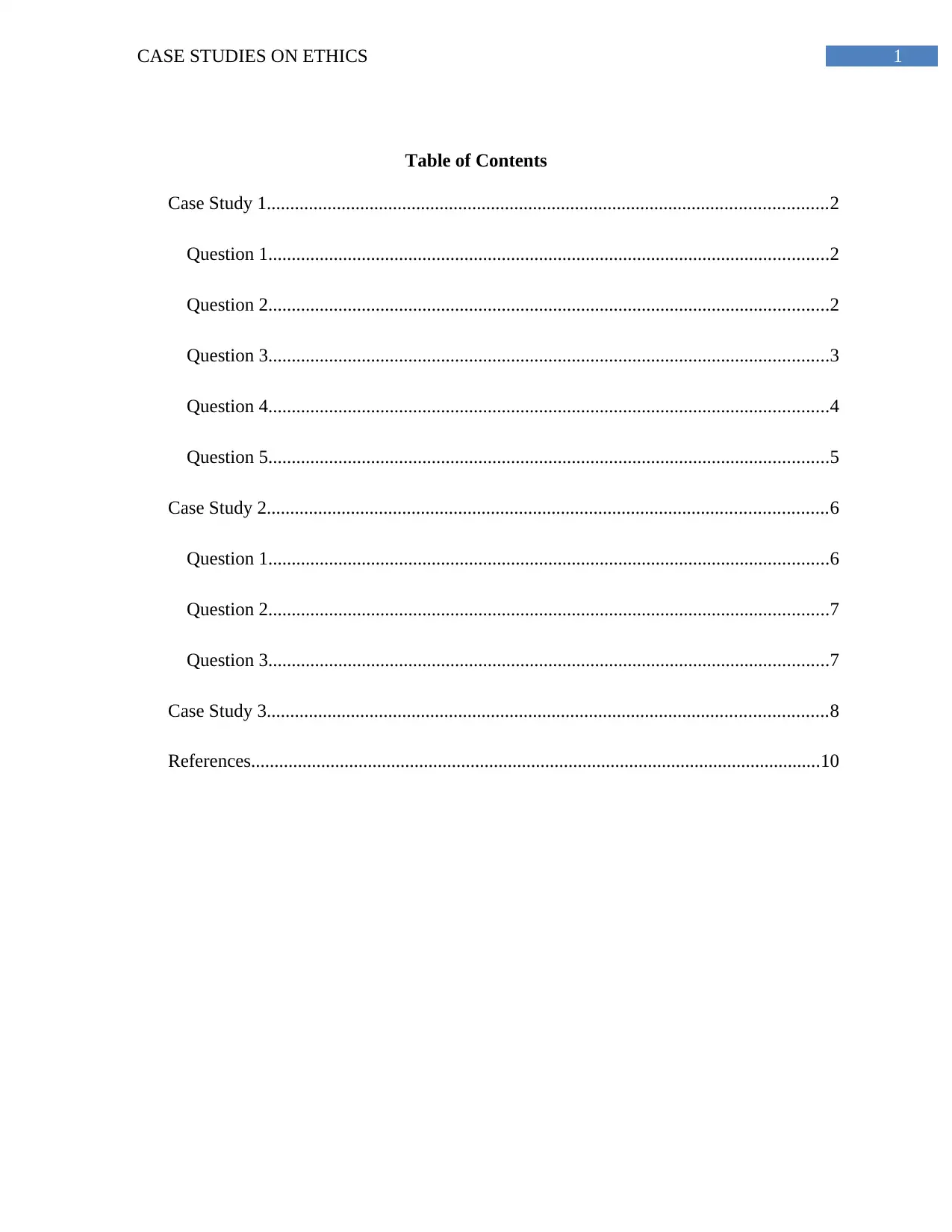
1CASE STUDIES ON ETHICS
Table of Contents
Case Study 1........................................................................................................................2
Question 1........................................................................................................................2
Question 2........................................................................................................................2
Question 3........................................................................................................................3
Question 4........................................................................................................................4
Question 5........................................................................................................................5
Case Study 2........................................................................................................................6
Question 1........................................................................................................................6
Question 2........................................................................................................................7
Question 3........................................................................................................................7
Case Study 3........................................................................................................................8
References..........................................................................................................................10
Table of Contents
Case Study 1........................................................................................................................2
Question 1........................................................................................................................2
Question 2........................................................................................................................2
Question 3........................................................................................................................3
Question 4........................................................................................................................4
Question 5........................................................................................................................5
Case Study 2........................................................................................................................6
Question 1........................................................................................................................6
Question 2........................................................................................................................7
Question 3........................................................................................................................7
Case Study 3........................................................................................................................8
References..........................................................................................................................10
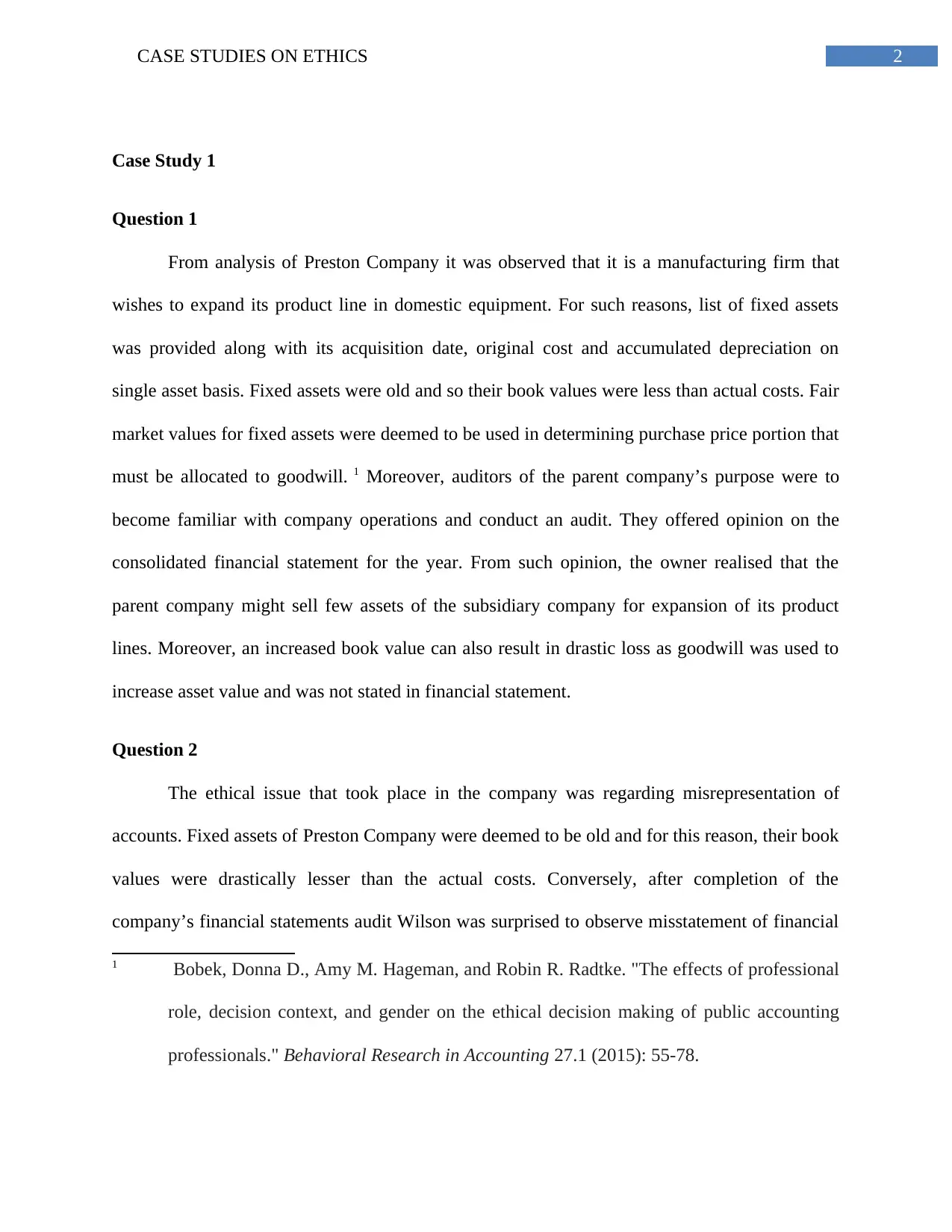
2CASE STUDIES ON ETHICS
Case Study 1
Question 1
From analysis of Preston Company it was observed that it is a manufacturing firm that
wishes to expand its product line in domestic equipment. For such reasons, list of fixed assets
was provided along with its acquisition date, original cost and accumulated depreciation on
single asset basis. Fixed assets were old and so their book values were less than actual costs. Fair
market values for fixed assets were deemed to be used in determining purchase price portion that
must be allocated to goodwill. 1 Moreover, auditors of the parent company’s purpose were to
become familiar with company operations and conduct an audit. They offered opinion on the
consolidated financial statement for the year. From such opinion, the owner realised that the
parent company might sell few assets of the subsidiary company for expansion of its product
lines. Moreover, an increased book value can also result in drastic loss as goodwill was used to
increase asset value and was not stated in financial statement.
Question 2
The ethical issue that took place in the company was regarding misrepresentation of
accounts. Fixed assets of Preston Company were deemed to be old and for this reason, their book
values were drastically lesser than the actual costs. Conversely, after completion of the
company’s financial statements audit Wilson was surprised to observe misstatement of financial
1 Bobek, Donna D., Amy M. Hageman, and Robin R. Radtke. "The effects of professional
role, decision context, and gender on the ethical decision making of public accounting
professionals." Behavioral Research in Accounting 27.1 (2015): 55-78.
Case Study 1
Question 1
From analysis of Preston Company it was observed that it is a manufacturing firm that
wishes to expand its product line in domestic equipment. For such reasons, list of fixed assets
was provided along with its acquisition date, original cost and accumulated depreciation on
single asset basis. Fixed assets were old and so their book values were less than actual costs. Fair
market values for fixed assets were deemed to be used in determining purchase price portion that
must be allocated to goodwill. 1 Moreover, auditors of the parent company’s purpose were to
become familiar with company operations and conduct an audit. They offered opinion on the
consolidated financial statement for the year. From such opinion, the owner realised that the
parent company might sell few assets of the subsidiary company for expansion of its product
lines. Moreover, an increased book value can also result in drastic loss as goodwill was used to
increase asset value and was not stated in financial statement.
Question 2
The ethical issue that took place in the company was regarding misrepresentation of
accounts. Fixed assets of Preston Company were deemed to be old and for this reason, their book
values were drastically lesser than the actual costs. Conversely, after completion of the
company’s financial statements audit Wilson was surprised to observe misstatement of financial
1 Bobek, Donna D., Amy M. Hageman, and Robin R. Radtke. "The effects of professional
role, decision context, and gender on the ethical decision making of public accounting
professionals." Behavioral Research in Accounting 27.1 (2015): 55-78.
⊘ This is a preview!⊘
Do you want full access?
Subscribe today to unlock all pages.

Trusted by 1+ million students worldwide
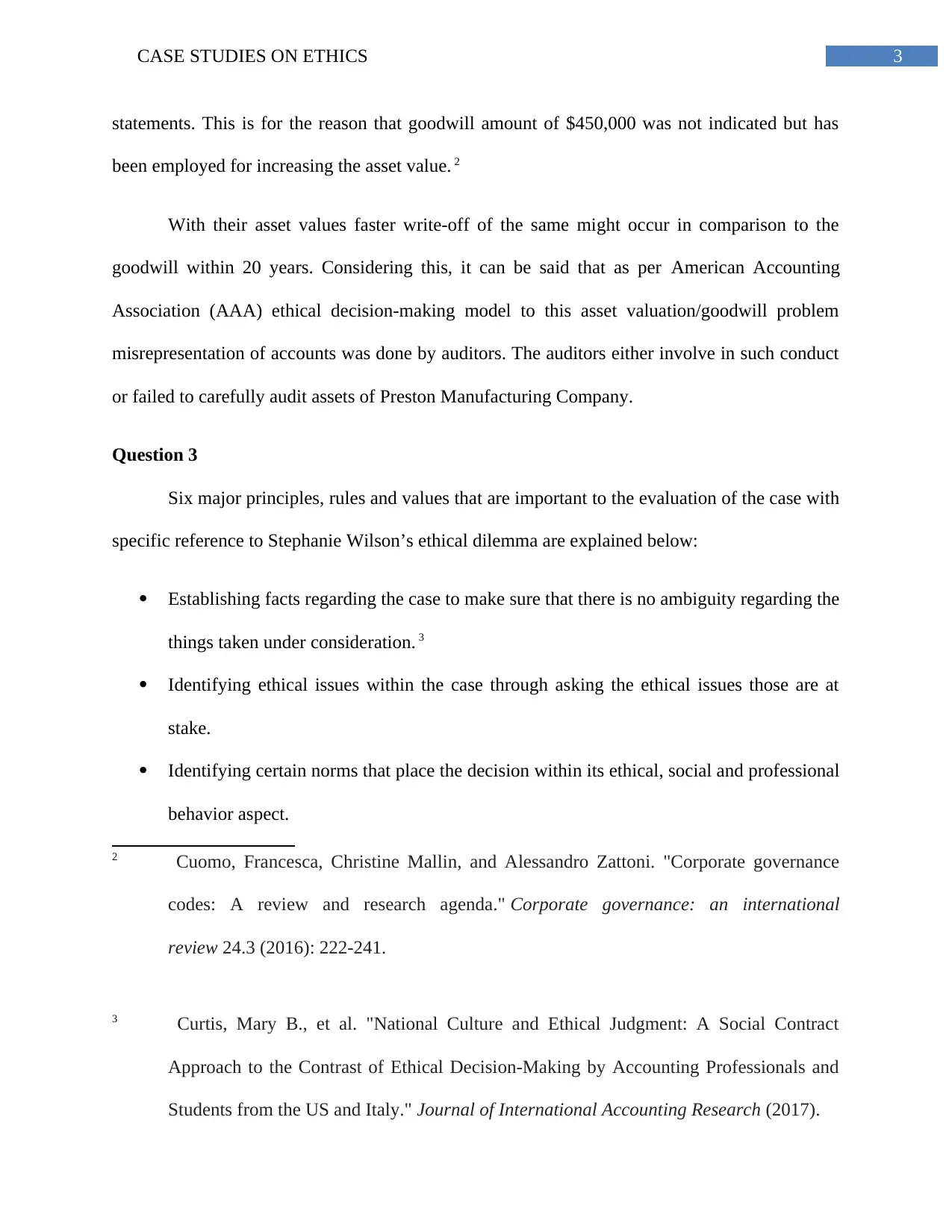
3CASE STUDIES ON ETHICS
statements. This is for the reason that goodwill amount of $450,000 was not indicated but has
been employed for increasing the asset value. 2
With their asset values faster write-off of the same might occur in comparison to the
goodwill within 20 years. Considering this, it can be said that as per American Accounting
Association (AAA) ethical decision-making model to this asset valuation/goodwill problem
misrepresentation of accounts was done by auditors. The auditors either involve in such conduct
or failed to carefully audit assets of Preston Manufacturing Company.
Question 3
Six major principles, rules and values that are important to the evaluation of the case with
specific reference to Stephanie Wilson’s ethical dilemma are explained below:
Establishing facts regarding the case to make sure that there is no ambiguity regarding the
things taken under consideration. 3
Identifying ethical issues within the case through asking the ethical issues those are at
stake.
Identifying certain norms that place the decision within its ethical, social and professional
behavior aspect.
2 Cuomo, Francesca, Christine Mallin, and Alessandro Zattoni. "Corporate governance
codes: A review and research agenda." Corporate governance: an international
review 24.3 (2016): 222-241.
3 Curtis, Mary B., et al. "National Culture and Ethical Judgment: A Social Contract
Approach to the Contrast of Ethical Decision-Making by Accounting Professionals and
Students from the US and Italy." Journal of International Accounting Research (2017).
statements. This is for the reason that goodwill amount of $450,000 was not indicated but has
been employed for increasing the asset value. 2
With their asset values faster write-off of the same might occur in comparison to the
goodwill within 20 years. Considering this, it can be said that as per American Accounting
Association (AAA) ethical decision-making model to this asset valuation/goodwill problem
misrepresentation of accounts was done by auditors. The auditors either involve in such conduct
or failed to carefully audit assets of Preston Manufacturing Company.
Question 3
Six major principles, rules and values that are important to the evaluation of the case with
specific reference to Stephanie Wilson’s ethical dilemma are explained below:
Establishing facts regarding the case to make sure that there is no ambiguity regarding the
things taken under consideration. 3
Identifying ethical issues within the case through asking the ethical issues those are at
stake.
Identifying certain norms that place the decision within its ethical, social and professional
behavior aspect.
2 Cuomo, Francesca, Christine Mallin, and Alessandro Zattoni. "Corporate governance
codes: A review and research agenda." Corporate governance: an international
review 24.3 (2016): 222-241.
3 Curtis, Mary B., et al. "National Culture and Ethical Judgment: A Social Contract
Approach to the Contrast of Ethical Decision-Making by Accounting Professionals and
Students from the US and Italy." Journal of International Accounting Research (2017).
Paraphrase This Document
Need a fresh take? Get an instant paraphrase of this document with our AI Paraphraser
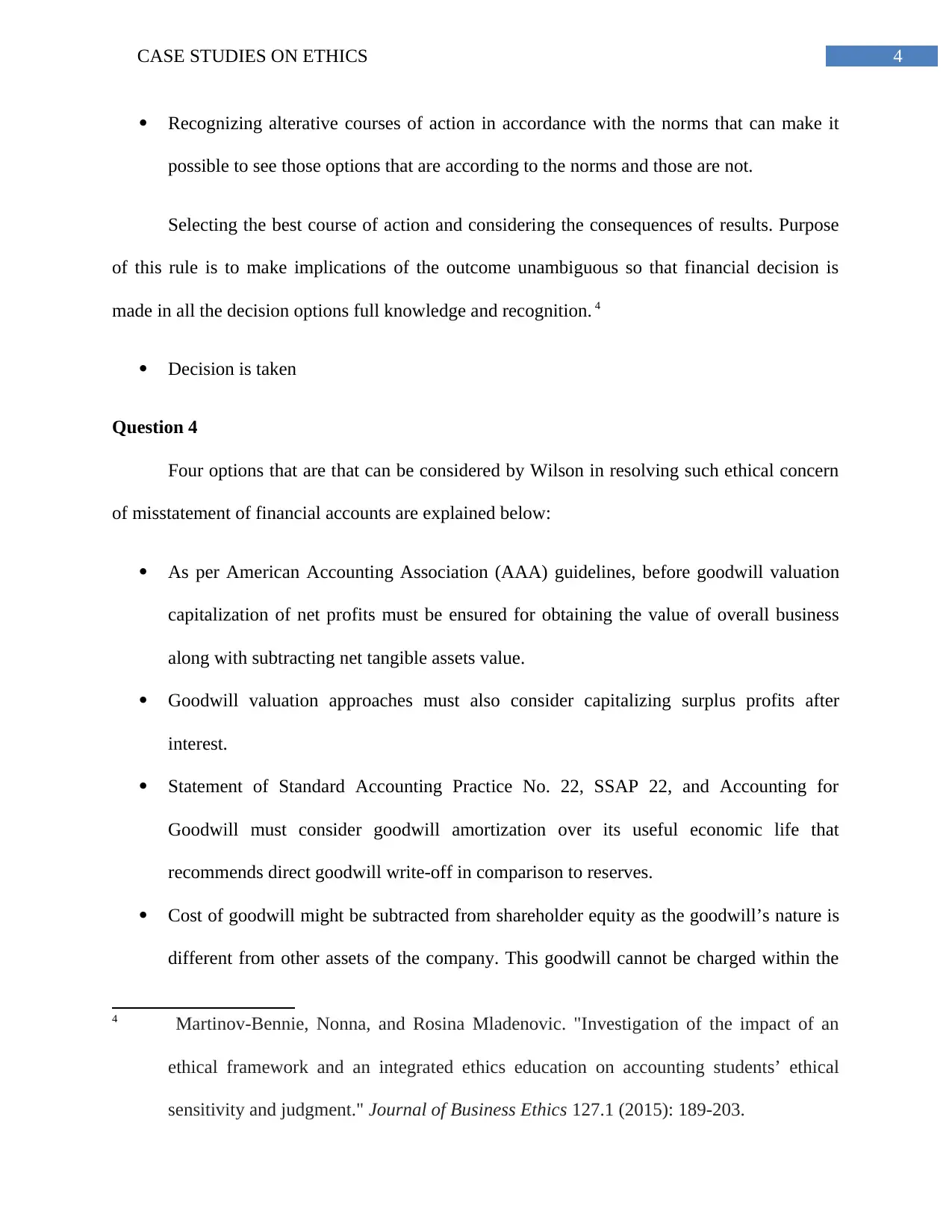
4CASE STUDIES ON ETHICS
Recognizing alterative courses of action in accordance with the norms that can make it
possible to see those options that are according to the norms and those are not.
Selecting the best course of action and considering the consequences of results. Purpose
of this rule is to make implications of the outcome unambiguous so that financial decision is
made in all the decision options full knowledge and recognition. 4
Decision is taken
Question 4
Four options that are that can be considered by Wilson in resolving such ethical concern
of misstatement of financial accounts are explained below:
As per American Accounting Association (AAA) guidelines, before goodwill valuation
capitalization of net profits must be ensured for obtaining the value of overall business
along with subtracting net tangible assets value.
Goodwill valuation approaches must also consider capitalizing surplus profits after
interest.
Statement of Standard Accounting Practice No. 22, SSAP 22, and Accounting for
Goodwill must consider goodwill amortization over its useful economic life that
recommends direct goodwill write-off in comparison to reserves.
Cost of goodwill might be subtracted from shareholder equity as the goodwill’s nature is
different from other assets of the company. This goodwill cannot be charged within the
4 Martinov-Bennie, Nonna, and Rosina Mladenovic. "Investigation of the impact of an
ethical framework and an integrated ethics education on accounting students’ ethical
sensitivity and judgment." Journal of Business Ethics 127.1 (2015): 189-203.
Recognizing alterative courses of action in accordance with the norms that can make it
possible to see those options that are according to the norms and those are not.
Selecting the best course of action and considering the consequences of results. Purpose
of this rule is to make implications of the outcome unambiguous so that financial decision is
made in all the decision options full knowledge and recognition. 4
Decision is taken
Question 4
Four options that are that can be considered by Wilson in resolving such ethical concern
of misstatement of financial accounts are explained below:
As per American Accounting Association (AAA) guidelines, before goodwill valuation
capitalization of net profits must be ensured for obtaining the value of overall business
along with subtracting net tangible assets value.
Goodwill valuation approaches must also consider capitalizing surplus profits after
interest.
Statement of Standard Accounting Practice No. 22, SSAP 22, and Accounting for
Goodwill must consider goodwill amortization over its useful economic life that
recommends direct goodwill write-off in comparison to reserves.
Cost of goodwill might be subtracted from shareholder equity as the goodwill’s nature is
different from other assets of the company. This goodwill cannot be charged within the
4 Martinov-Bennie, Nonna, and Rosina Mladenovic. "Investigation of the impact of an
ethical framework and an integrated ethics education on accounting students’ ethical
sensitivity and judgment." Journal of Business Ethics 127.1 (2015): 189-203.
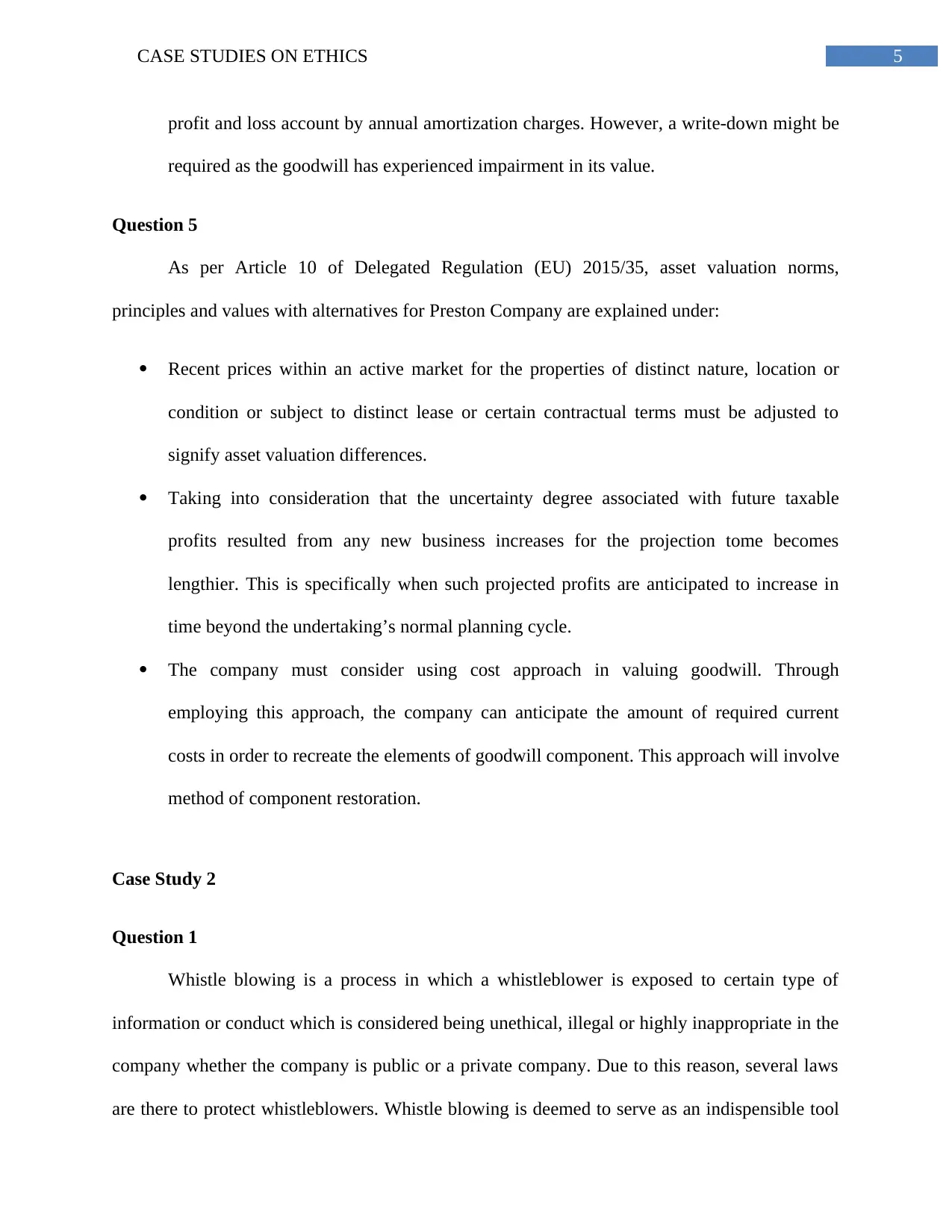
5CASE STUDIES ON ETHICS
profit and loss account by annual amortization charges. However, a write-down might be
required as the goodwill has experienced impairment in its value.
Question 5
As per Article 10 of Delegated Regulation (EU) 2015/35, asset valuation norms,
principles and values with alternatives for Preston Company are explained under:
Recent prices within an active market for the properties of distinct nature, location or
condition or subject to distinct lease or certain contractual terms must be adjusted to
signify asset valuation differences.
Taking into consideration that the uncertainty degree associated with future taxable
profits resulted from any new business increases for the projection tome becomes
lengthier. This is specifically when such projected profits are anticipated to increase in
time beyond the undertaking’s normal planning cycle.
The company must consider using cost approach in valuing goodwill. Through
employing this approach, the company can anticipate the amount of required current
costs in order to recreate the elements of goodwill component. This approach will involve
method of component restoration.
Case Study 2
Question 1
Whistle blowing is a process in which a whistleblower is exposed to certain type of
information or conduct which is considered being unethical, illegal or highly inappropriate in the
company whether the company is public or a private company. Due to this reason, several laws
are there to protect whistleblowers. Whistle blowing is deemed to serve as an indispensible tool
profit and loss account by annual amortization charges. However, a write-down might be
required as the goodwill has experienced impairment in its value.
Question 5
As per Article 10 of Delegated Regulation (EU) 2015/35, asset valuation norms,
principles and values with alternatives for Preston Company are explained under:
Recent prices within an active market for the properties of distinct nature, location or
condition or subject to distinct lease or certain contractual terms must be adjusted to
signify asset valuation differences.
Taking into consideration that the uncertainty degree associated with future taxable
profits resulted from any new business increases for the projection tome becomes
lengthier. This is specifically when such projected profits are anticipated to increase in
time beyond the undertaking’s normal planning cycle.
The company must consider using cost approach in valuing goodwill. Through
employing this approach, the company can anticipate the amount of required current
costs in order to recreate the elements of goodwill component. This approach will involve
method of component restoration.
Case Study 2
Question 1
Whistle blowing is a process in which a whistleblower is exposed to certain type of
information or conduct which is considered being unethical, illegal or highly inappropriate in the
company whether the company is public or a private company. Due to this reason, several laws
are there to protect whistleblowers. Whistle blowing is deemed to serve as an indispensible tool
⊘ This is a preview!⊘
Do you want full access?
Subscribe today to unlock all pages.

Trusted by 1+ million students worldwide
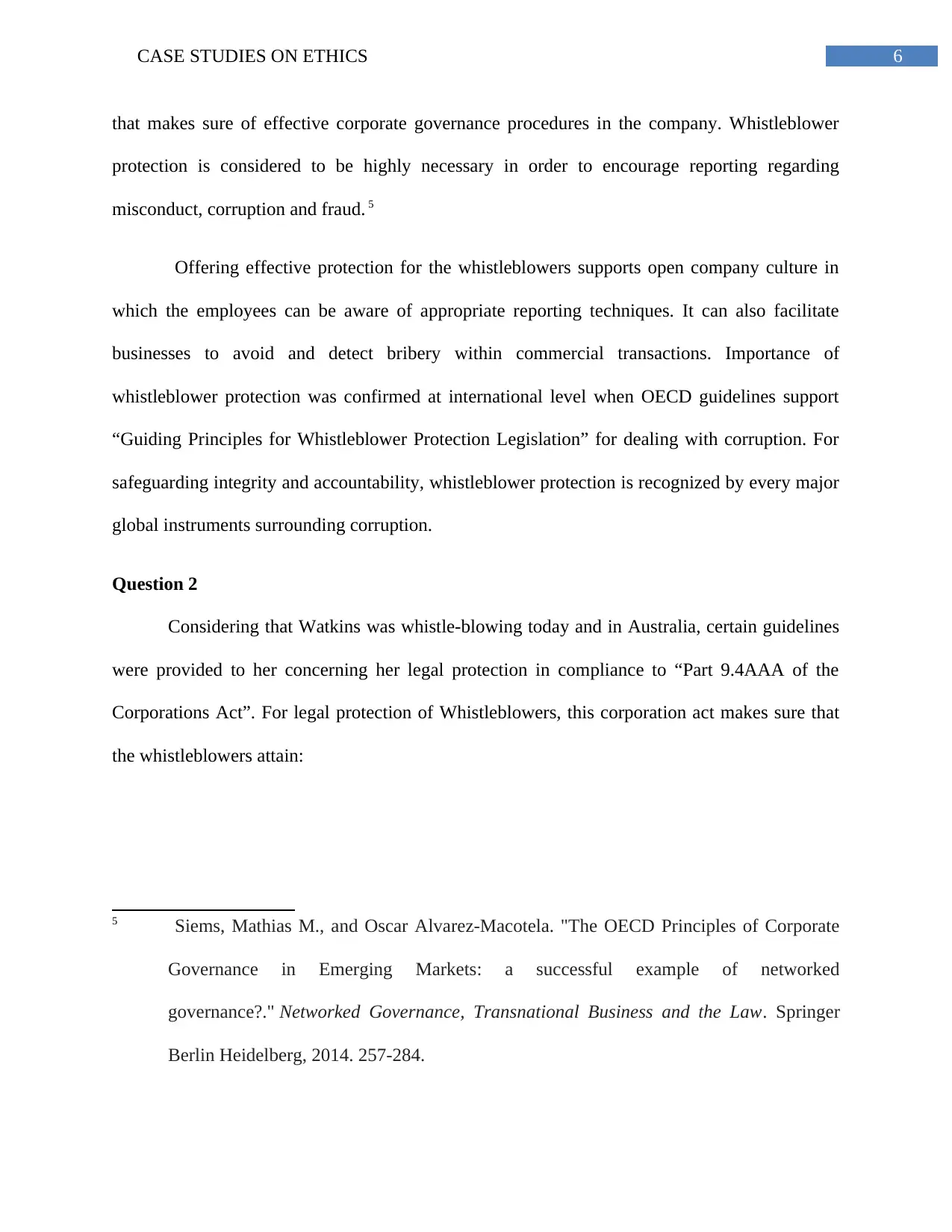
6CASE STUDIES ON ETHICS
that makes sure of effective corporate governance procedures in the company. Whistleblower
protection is considered to be highly necessary in order to encourage reporting regarding
misconduct, corruption and fraud. 5
Offering effective protection for the whistleblowers supports open company culture in
which the employees can be aware of appropriate reporting techniques. It can also facilitate
businesses to avoid and detect bribery within commercial transactions. Importance of
whistleblower protection was confirmed at international level when OECD guidelines support
“Guiding Principles for Whistleblower Protection Legislation” for dealing with corruption. For
safeguarding integrity and accountability, whistleblower protection is recognized by every major
global instruments surrounding corruption.
Question 2
Considering that Watkins was whistle-blowing today and in Australia, certain guidelines
were provided to her concerning her legal protection in compliance to “Part 9.4AAA of the
Corporations Act”. For legal protection of Whistleblowers, this corporation act makes sure that
the whistleblowers attain:
5 Siems, Mathias M., and Oscar Alvarez-Macotela. "The OECD Principles of Corporate
Governance in Emerging Markets: a successful example of networked
governance?." Networked Governance, Transnational Business and the Law. Springer
Berlin Heidelberg, 2014. 257-284.
that makes sure of effective corporate governance procedures in the company. Whistleblower
protection is considered to be highly necessary in order to encourage reporting regarding
misconduct, corruption and fraud. 5
Offering effective protection for the whistleblowers supports open company culture in
which the employees can be aware of appropriate reporting techniques. It can also facilitate
businesses to avoid and detect bribery within commercial transactions. Importance of
whistleblower protection was confirmed at international level when OECD guidelines support
“Guiding Principles for Whistleblower Protection Legislation” for dealing with corruption. For
safeguarding integrity and accountability, whistleblower protection is recognized by every major
global instruments surrounding corruption.
Question 2
Considering that Watkins was whistle-blowing today and in Australia, certain guidelines
were provided to her concerning her legal protection in compliance to “Part 9.4AAA of the
Corporations Act”. For legal protection of Whistleblowers, this corporation act makes sure that
the whistleblowers attain:
5 Siems, Mathias M., and Oscar Alvarez-Macotela. "The OECD Principles of Corporate
Governance in Emerging Markets: a successful example of networked
governance?." Networked Governance, Transnational Business and the Law. Springer
Berlin Heidelberg, 2014. 257-284.
Paraphrase This Document
Need a fresh take? Get an instant paraphrase of this document with our AI Paraphraser
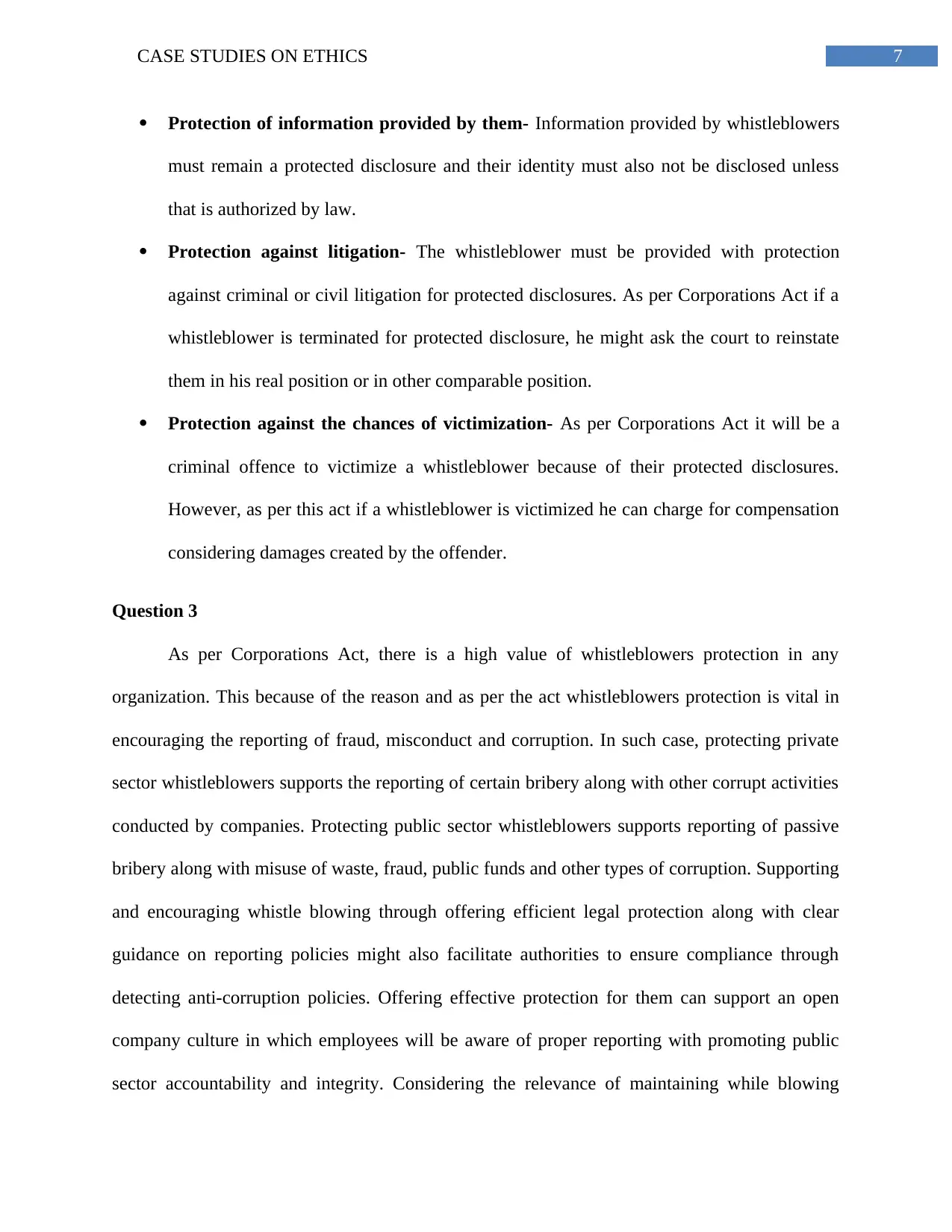
7CASE STUDIES ON ETHICS
Protection of information provided by them- Information provided by whistleblowers
must remain a protected disclosure and their identity must also not be disclosed unless
that is authorized by law.
Protection against litigation- The whistleblower must be provided with protection
against criminal or civil litigation for protected disclosures. As per Corporations Act if a
whistleblower is terminated for protected disclosure, he might ask the court to reinstate
them in his real position or in other comparable position.
Protection against the chances of victimization- As per Corporations Act it will be a
criminal offence to victimize a whistleblower because of their protected disclosures.
However, as per this act if a whistleblower is victimized he can charge for compensation
considering damages created by the offender.
Question 3
As per Corporations Act, there is a high value of whistleblowers protection in any
organization. This because of the reason and as per the act whistleblowers protection is vital in
encouraging the reporting of fraud, misconduct and corruption. In such case, protecting private
sector whistleblowers supports the reporting of certain bribery along with other corrupt activities
conducted by companies. Protecting public sector whistleblowers supports reporting of passive
bribery along with misuse of waste, fraud, public funds and other types of corruption. Supporting
and encouraging whistle blowing through offering efficient legal protection along with clear
guidance on reporting policies might also facilitate authorities to ensure compliance through
detecting anti-corruption policies. Offering effective protection for them can support an open
company culture in which employees will be aware of proper reporting with promoting public
sector accountability and integrity. Considering the relevance of maintaining while blowing
Protection of information provided by them- Information provided by whistleblowers
must remain a protected disclosure and their identity must also not be disclosed unless
that is authorized by law.
Protection against litigation- The whistleblower must be provided with protection
against criminal or civil litigation for protected disclosures. As per Corporations Act if a
whistleblower is terminated for protected disclosure, he might ask the court to reinstate
them in his real position or in other comparable position.
Protection against the chances of victimization- As per Corporations Act it will be a
criminal offence to victimize a whistleblower because of their protected disclosures.
However, as per this act if a whistleblower is victimized he can charge for compensation
considering damages created by the offender.
Question 3
As per Corporations Act, there is a high value of whistleblowers protection in any
organization. This because of the reason and as per the act whistleblowers protection is vital in
encouraging the reporting of fraud, misconduct and corruption. In such case, protecting private
sector whistleblowers supports the reporting of certain bribery along with other corrupt activities
conducted by companies. Protecting public sector whistleblowers supports reporting of passive
bribery along with misuse of waste, fraud, public funds and other types of corruption. Supporting
and encouraging whistle blowing through offering efficient legal protection along with clear
guidance on reporting policies might also facilitate authorities to ensure compliance through
detecting anti-corruption policies. Offering effective protection for them can support an open
company culture in which employees will be aware of proper reporting with promoting public
sector accountability and integrity. Considering the relevance of maintaining while blowing
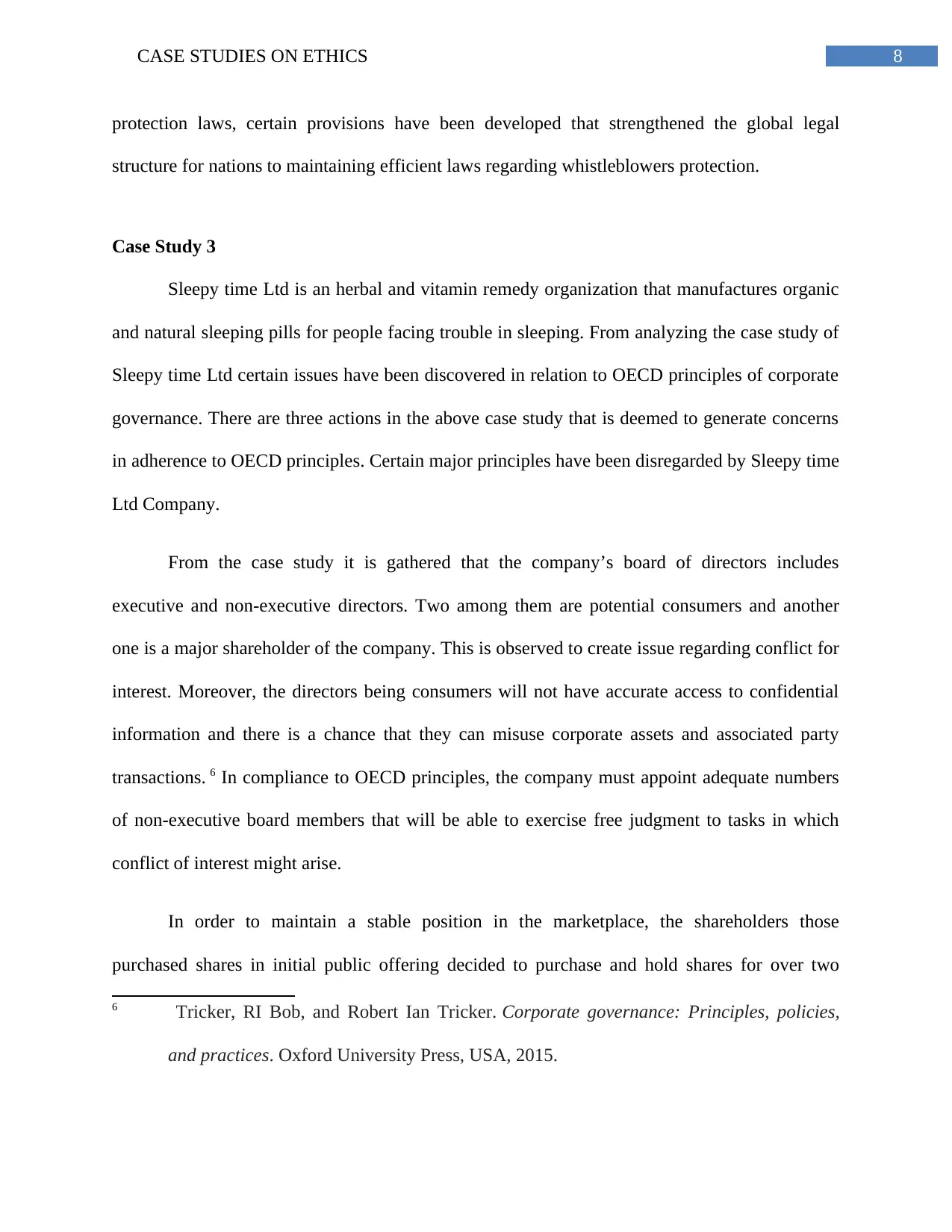
8CASE STUDIES ON ETHICS
protection laws, certain provisions have been developed that strengthened the global legal
structure for nations to maintaining efficient laws regarding whistleblowers protection.
Case Study 3
Sleepy time Ltd is an herbal and vitamin remedy organization that manufactures organic
and natural sleeping pills for people facing trouble in sleeping. From analyzing the case study of
Sleepy time Ltd certain issues have been discovered in relation to OECD principles of corporate
governance. There are three actions in the above case study that is deemed to generate concerns
in adherence to OECD principles. Certain major principles have been disregarded by Sleepy time
Ltd Company.
From the case study it is gathered that the company’s board of directors includes
executive and non-executive directors. Two among them are potential consumers and another
one is a major shareholder of the company. This is observed to create issue regarding conflict for
interest. Moreover, the directors being consumers will not have accurate access to confidential
information and there is a chance that they can misuse corporate assets and associated party
transactions. 6 In compliance to OECD principles, the company must appoint adequate numbers
of non-executive board members that will be able to exercise free judgment to tasks in which
conflict of interest might arise.
In order to maintain a stable position in the marketplace, the shareholders those
purchased shares in initial public offering decided to purchase and hold shares for over two
6 Tricker, RI Bob, and Robert Ian Tricker. Corporate governance: Principles, policies,
and practices. Oxford University Press, USA, 2015.
protection laws, certain provisions have been developed that strengthened the global legal
structure for nations to maintaining efficient laws regarding whistleblowers protection.
Case Study 3
Sleepy time Ltd is an herbal and vitamin remedy organization that manufactures organic
and natural sleeping pills for people facing trouble in sleeping. From analyzing the case study of
Sleepy time Ltd certain issues have been discovered in relation to OECD principles of corporate
governance. There are three actions in the above case study that is deemed to generate concerns
in adherence to OECD principles. Certain major principles have been disregarded by Sleepy time
Ltd Company.
From the case study it is gathered that the company’s board of directors includes
executive and non-executive directors. Two among them are potential consumers and another
one is a major shareholder of the company. This is observed to create issue regarding conflict for
interest. Moreover, the directors being consumers will not have accurate access to confidential
information and there is a chance that they can misuse corporate assets and associated party
transactions. 6 In compliance to OECD principles, the company must appoint adequate numbers
of non-executive board members that will be able to exercise free judgment to tasks in which
conflict of interest might arise.
In order to maintain a stable position in the marketplace, the shareholders those
purchased shares in initial public offering decided to purchase and hold shares for over two
6 Tricker, RI Bob, and Robert Ian Tricker. Corporate governance: Principles, policies,
and practices. Oxford University Press, USA, 2015.
⊘ This is a preview!⊘
Do you want full access?
Subscribe today to unlock all pages.

Trusted by 1+ million students worldwide
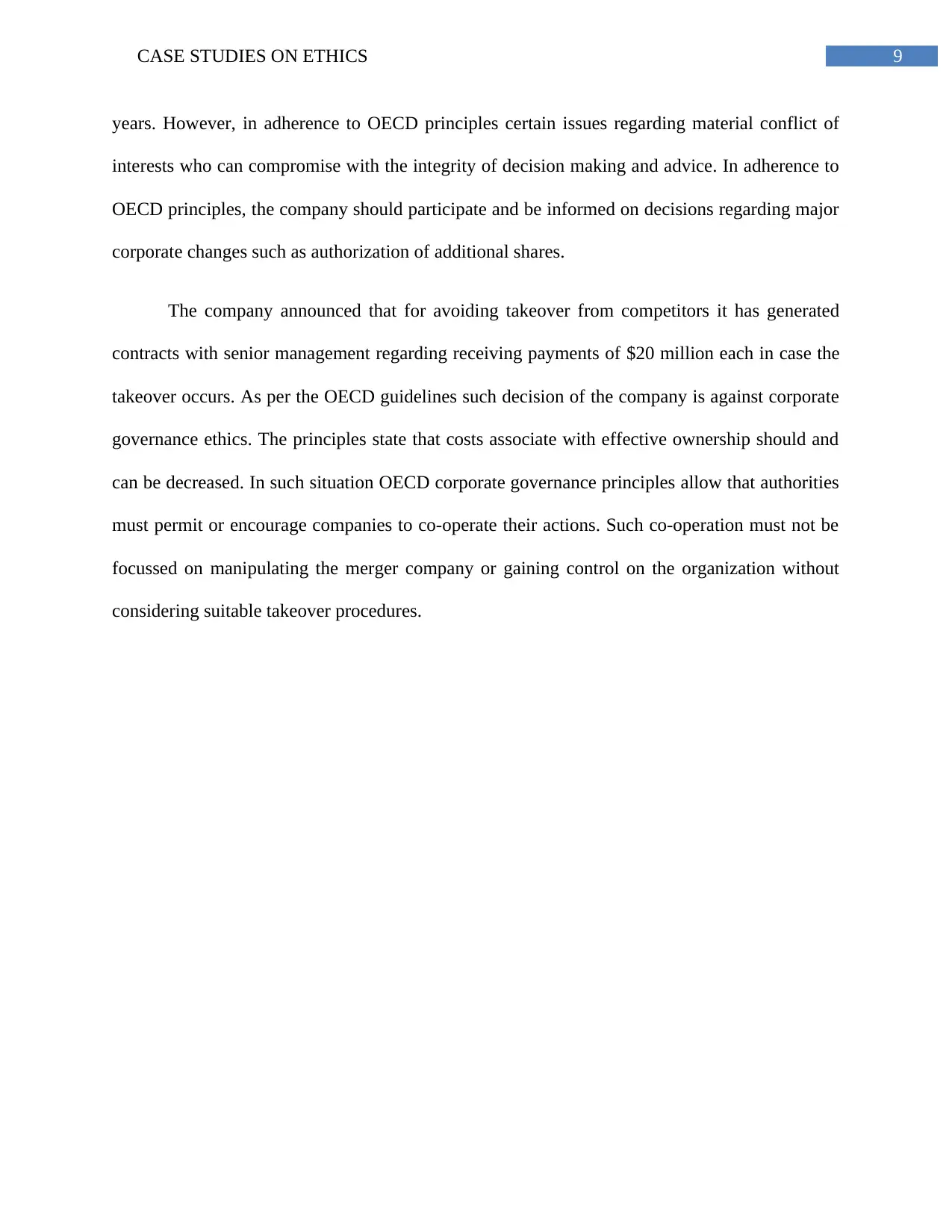
9CASE STUDIES ON ETHICS
years. However, in adherence to OECD principles certain issues regarding material conflict of
interests who can compromise with the integrity of decision making and advice. In adherence to
OECD principles, the company should participate and be informed on decisions regarding major
corporate changes such as authorization of additional shares.
The company announced that for avoiding takeover from competitors it has generated
contracts with senior management regarding receiving payments of $20 million each in case the
takeover occurs. As per the OECD guidelines such decision of the company is against corporate
governance ethics. The principles state that costs associate with effective ownership should and
can be decreased. In such situation OECD corporate governance principles allow that authorities
must permit or encourage companies to co-operate their actions. Such co-operation must not be
focussed on manipulating the merger company or gaining control on the organization without
considering suitable takeover procedures.
years. However, in adherence to OECD principles certain issues regarding material conflict of
interests who can compromise with the integrity of decision making and advice. In adherence to
OECD principles, the company should participate and be informed on decisions regarding major
corporate changes such as authorization of additional shares.
The company announced that for avoiding takeover from competitors it has generated
contracts with senior management regarding receiving payments of $20 million each in case the
takeover occurs. As per the OECD guidelines such decision of the company is against corporate
governance ethics. The principles state that costs associate with effective ownership should and
can be decreased. In such situation OECD corporate governance principles allow that authorities
must permit or encourage companies to co-operate their actions. Such co-operation must not be
focussed on manipulating the merger company or gaining control on the organization without
considering suitable takeover procedures.
Paraphrase This Document
Need a fresh take? Get an instant paraphrase of this document with our AI Paraphraser
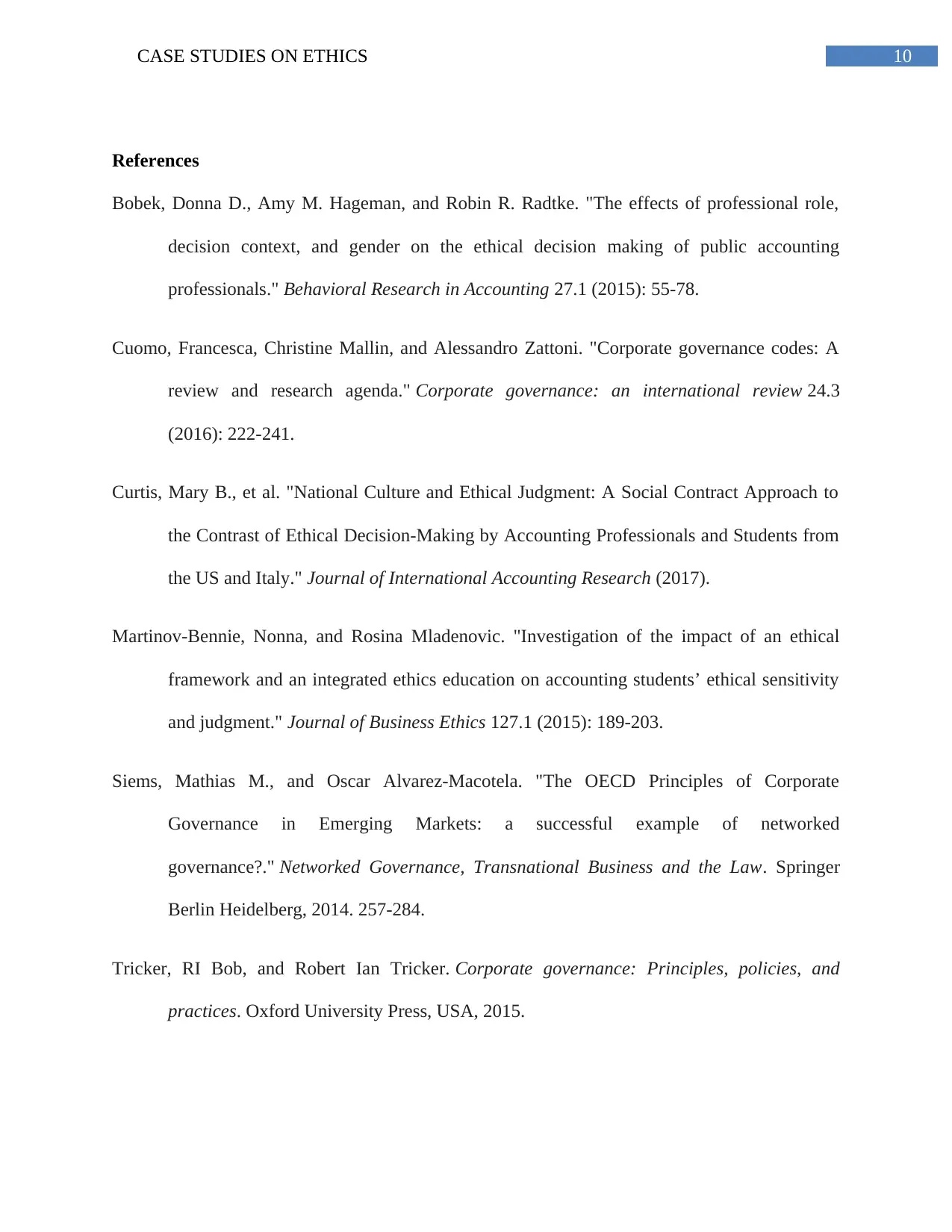
10CASE STUDIES ON ETHICS
References
Bobek, Donna D., Amy M. Hageman, and Robin R. Radtke. "The effects of professional role,
decision context, and gender on the ethical decision making of public accounting
professionals." Behavioral Research in Accounting 27.1 (2015): 55-78.
Cuomo, Francesca, Christine Mallin, and Alessandro Zattoni. "Corporate governance codes: A
review and research agenda." Corporate governance: an international review 24.3
(2016): 222-241.
Curtis, Mary B., et al. "National Culture and Ethical Judgment: A Social Contract Approach to
the Contrast of Ethical Decision-Making by Accounting Professionals and Students from
the US and Italy." Journal of International Accounting Research (2017).
Martinov-Bennie, Nonna, and Rosina Mladenovic. "Investigation of the impact of an ethical
framework and an integrated ethics education on accounting students’ ethical sensitivity
and judgment." Journal of Business Ethics 127.1 (2015): 189-203.
Siems, Mathias M., and Oscar Alvarez-Macotela. "The OECD Principles of Corporate
Governance in Emerging Markets: a successful example of networked
governance?." Networked Governance, Transnational Business and the Law. Springer
Berlin Heidelberg, 2014. 257-284.
Tricker, RI Bob, and Robert Ian Tricker. Corporate governance: Principles, policies, and
practices. Oxford University Press, USA, 2015.
References
Bobek, Donna D., Amy M. Hageman, and Robin R. Radtke. "The effects of professional role,
decision context, and gender on the ethical decision making of public accounting
professionals." Behavioral Research in Accounting 27.1 (2015): 55-78.
Cuomo, Francesca, Christine Mallin, and Alessandro Zattoni. "Corporate governance codes: A
review and research agenda." Corporate governance: an international review 24.3
(2016): 222-241.
Curtis, Mary B., et al. "National Culture and Ethical Judgment: A Social Contract Approach to
the Contrast of Ethical Decision-Making by Accounting Professionals and Students from
the US and Italy." Journal of International Accounting Research (2017).
Martinov-Bennie, Nonna, and Rosina Mladenovic. "Investigation of the impact of an ethical
framework and an integrated ethics education on accounting students’ ethical sensitivity
and judgment." Journal of Business Ethics 127.1 (2015): 189-203.
Siems, Mathias M., and Oscar Alvarez-Macotela. "The OECD Principles of Corporate
Governance in Emerging Markets: a successful example of networked
governance?." Networked Governance, Transnational Business and the Law. Springer
Berlin Heidelberg, 2014. 257-284.
Tricker, RI Bob, and Robert Ian Tricker. Corporate governance: Principles, policies, and
practices. Oxford University Press, USA, 2015.
1 out of 11
Related Documents
Your All-in-One AI-Powered Toolkit for Academic Success.
+13062052269
info@desklib.com
Available 24*7 on WhatsApp / Email
![[object Object]](/_next/static/media/star-bottom.7253800d.svg)
Unlock your academic potential
Copyright © 2020–2025 A2Z Services. All Rights Reserved. Developed and managed by ZUCOL.





